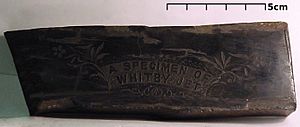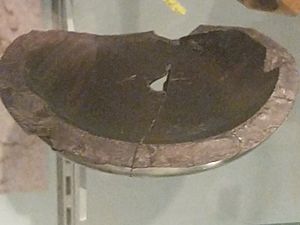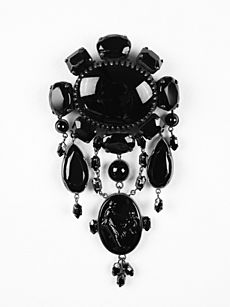Jet (gemstone) facts for kids
Quick facts for kids Jet |
|
|---|---|

Sample of unworked jet, about 15 mm long
|
|
| General | |
| Category | Mineraloid |
| Formula (repeating unit) |
Variable, but rich in carbon |
| Identification | |
| Color | Black, occasionally brown |
| Cleavage | None |
| Fracture | Conchoidal |
| Tenacity | Brittle |
| Mohs scale hardness | 2.5–4.0 |
| Streak | Brown |
| Specific gravity | 1.3–1.4 |
| Optical properties | Isotropic |
| Refractive index | 1.640–1.680 |
| Dispersion | None; opaque |
| Ultraviolet fluorescence | None |
| Common impurities | Iron, sulfur |
Jet is a special type of lignite, which is the lowest grade of coal. It's also considered a gemstone. Unlike most gemstones, jet isn't a mineral. Instead, it's a mineraloid, meaning it's a naturally occurring substance that doesn't quite fit the definition of a mineral. Jet forms from wood that has changed a lot under extreme pressure over millions of years.
The word "jet" comes from an old French word, jaiet, which refers to an ancient town called Gagae. Jet is usually black or dark brown. Sometimes, it has shiny, brass-colored spots called pyrite inclusions. The phrase "jet-black", meaning a very deep black, comes from this material.
Contents
How Does Jet Form?
Jet is made from wood that decomposed millions of years ago. This wood often came from trees in the Araucariaceae family, like the modern Chilean pine.
Jet comes in two main types: hard and soft.
- Hard jet forms when carbon from the wood is compressed in salt water.
- Soft jet forms when carbon is compressed in fresh water.
Even though they have different names, both types have a similar hardness on the Mohs scale. The main difference is that soft jet is more likely to crack if the temperature changes quickly.
What Are Jet's Properties?
Jet is mostly made of carbon (about 75%) and oxygen (about 12%). The rest is mostly sulfur and hydrogen. Small amounts of other elements can also be found. The exact mix of elements can vary depending on where the jet comes from. For example, jet from Spain has more sulfur than jet from Whitby, England.
Jet is fairly soft, with a Mohs hardness between 2.5 and 4. This means it can be scratched by harder materials. It has a specific gravity (how dense it is compared to water) of 1.30 to 1.34. Jet's refractive index is about 1.66, which describes how light bends when it passes through the material.
If you touch a red-hot needle to jet, it will smell like burning coal. This is a good way to tell it apart from other materials. Jet can also create an electric charge when you rub it, similar to amber.
Jet is quite easy to carve. However, making very small, detailed designs can be tricky because it might break. This means it takes a skilled carver to make complex jet pieces.
Where Is Jet Found?
Jet deposits are found in several places around the world.
Jet in England
The most famous jet comes from Whitby, England. This jet is part of a rock layer called the "Jet Rock" unit. It formed about 181 million years ago, during the Early Jurassic period. Whitby Jet is fossilized wood from trees similar to the Chilean pine. These deposits spread across the North York Moors National Park. Jet has also been found in Kimmeridge shale in Dorset, England.
Jet in France
Jet was mined in several areas of France, including Montjardin and Roquevaire. Raw jet was also brought in from Spain. In the 1700s, there was a jet carving industry around Sainte-Colombe-sur-l'Hers and La Bastide-sur-l'Hers. However, this industry declined in the 1800s. An attempt to bring French jet to Whitby in 1871 failed because the quality wasn't good enough.
Jet in Spain
The largest jet deposits in northern Spain are in Asturias. This jet is about 155 million years old, from the Late Jurassic period. Asturian jet is a type of coal that went through a special process, making it very stable over long periods. Jet is also found near Santiago de Compostela in northwest Spain.
Jet in the United States
Native American Navajo and Pueblo tribes in New Mexico used jet for jewelry and to decorate weapons when Spanish explorers arrived in the 1500s. Today, these jet deposits are known as Acoma jet. Large coal deposits in the San Juan Basin of New Mexico are linked to jet found in the Henry Mountains of Utah and El Paso County, Colorado.
Other Places Where Jet Is Found
Jet is also sold in Poland and near Erzurum in Turkey. In Turkey, it's called oltu stone and is used to make prayer beads.
A Look at Jet's History
The oldest known object made from jet is a tiny model of a botfly larva. It's from 10,000 BC and was found in Germany.
People in Britain have used jet since the Stone Age. It continued to be popular in the Bronze Age for things like necklace beads. Jet necklaces with flat plates and spacers might have been inspired by gold necklaces called lunulae. During the Iron Age, jet went out of style. It became popular again in Roman Britain around the 200s AD, but its popularity ended when Roman rule in Britain finished.
Early archaeologists sometimes confused jet with other similar dark materials. For example, in southern Britain, what was called jet was often Kimmeridge Shale. Some old artifacts even mix different jet-like materials.
Jet Use by Romans
Whitby jet was very popular for jewelry in Roman Britain starting in the 200s AD. There's no proof that jet was worked in Whitby itself. Instead, it was taken to Eboracum (which is now York), where many signs of jet production have been found. At that time, people collected jet by beachcombing (finding it on beaches) rather than digging for it.
Romans used jet for rings, hairpins, beads, bracelets, necklaces, and pendants. Many of these can be seen in the Yorkshire Museum. Jet rings often looked like metal rings. Jet pendants were carved with designs, and the head of Medusa was a common theme.
Similar jet items found in Germany suggest that pieces made in Eboracum were sent there. One type of jet bracelet with gold inserts has been found around the Rhine River but not in Britain.
Romans also believed jet had magical powers. They often used it in amulets and pendants because they thought it could protect them and ward off the evil eye. Ancient writers like Pliny the Elder mentioned jet. He suggested that burning jet could drive away snakes and help with certain illnesses.
Jet Use by Vikings
The Vikings also used jet for things like rings and small animal sculptures. Snakes were a popular animal to carve. We're not sure where the Vikings got their jet, but Whitby is the most likely place.
Jet in Medieval Times
During the Middle Ages, jet was mostly used for religious items, such as crosses and Rosary beads. People at the time believed that drinking water from jet bowls could help with childbirth. A jet bowl in the Museum of London might have been made for this purpose.
Jet in Victorian Times
Jet became very popular as a gemstone during the time of Queen Victoria. It first became fashionable in the 1850s when the Queen wore a jet necklace while mourning the death of Princess Victoria of Saxe-Coburg and Gotha. Later, she wore Whitby jet as part of her mourning dress after her husband, Prince Albert, died.
Sometimes, jet was combined with cut steel in jewelry designs of that time.
Jet's popularity peaked in the early 1870s and then began to decline. The number of workers in the jet trade in Whitby dropped from over 1,000 to just 300 by 1884. While other materials pretending to be jet might have played a role, the main reason was changes in fashion. The Art Nouveau style, for example, didn't use much black jewelry. As demand fell, the remaining jet makers often stuck to old styles instead of trying new ones, which made demand drop even more. Making small souvenirs for tourists kept a few jewelers busy, but by the end of World War II, only three remained. The industry completely died out when they passed away.
Jet in the 20th Century
In Whitby, the Victorian tradition of jet jewelry continued until after World War II. Jet jewelry (both old and new) then went out of style until the late 1970s. In the 1980s, jet beads became fashionable, and the value of antique jet jewelry started to rise. New jewelers began making jet jewelry again.
What Are Jet Substitutes?
Many materials were used to imitate jet when it was popular.
- Glass was a common substitute. When used this way, it was called French jet or Vauxhall glass.
- Ebonite (a type of hard rubber) also looked very similar to jet at first. However, ebonite fades over time.
- Sometimes, small pieces of jet were mixed with glue and molded into jewelry.
- Anthracite (hard coal) looks a lot like fine jet and was used to imitate it. It can be hard to tell the difference between anthracite and real jet.
- Some museums have made copies of jet artifacts using epoxy resin.
How Can You Tell if It's Real Jet?
There are a few ways to check if a piece is real jet:
- Temperature: Unlike black glass, which feels cool to the touch, jet does not feel cool. This is because it doesn't conduct heat as well.
- Streak Test: If you rub real jet against unglazed porcelain, it will leave a brown streak. However, some other materials like bog oak, vulcanite, and lignite will also do this.
- Burning Test: If you put real jet in a flame, it will burn like coal. It will give off a coal-like smell and produce soot. No other black "gemstone" behaves this way. This test is destructive, so it's usually only used if other tests aren't enough.
- Advanced Testing: For more precise identification without damaging the item, scientists use X-ray fluorescence spectroscopy along with looking at it closely (even under a microscope) and X-ray imaging. This can help tell jet apart from lignite.
See also
 In Spanish: Azabache para niños
In Spanish: Azabache para niños
- Petrified wood
- Oltu stone






